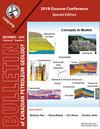An Alternative Interpretation for the Origin of Black Shale in the Bakken Formation of the Williston Basin
Q3 Earth and Planetary Sciences
引用次数: 5
Abstract
Recently, most researchers have argued for a deep-water origin for black shale in the Bakken Formation of the Williston basin based on sedimentology, paleontology and geochemistry characteristics that place black, laminated, sparsely fossiliferous, radiolarian, pyritic shale as the seaward lithology in an assemblage that originally transitioned landward into shallow-water facies. The shallow-water interpretation advocated in this paper is based on stratigraphic characteristics that include the absence of strata that represent a landward equivalent to the shale, gradual landward shale pinchouts, the restriction of Bakken strata to basinal areas, the Bakken onlap depositional style, and placement of a major maximum flooding surface near the base of the overlying Lodgepole. Black mud deposition in the Bakken is interpreted to have occurred in a low-relief, semi-enclosed, epeiric-lagoon environment with typical water depths of 0–30 m. It is theorized that a high-rainfall climate caused salinity stratification that produced bottom-water anoxia, which preserved organic material. Perhumid climate conditions (year-round rainfall) fostered thick soils and dense vegetation that limited sediment release and induced mud-dominated, sand-poor deposition. During middle Bakken deposition, an arid to semi-arid climate eliminated the bottom-water anoxic conditions and caused carbonate-siliciclastic deposition. The abrupt vertical transitions from black shale (lower Bakken), to carbonate-siliciclastic lithologies (middle Bakken), to black shale (upper Bakken) were caused by paleoclimate change.威利斯顿盆地巴肯组黑色页岩成因的另一种解释
最近,大多数研究人员根据沉积学、古生物学和地球化学特征,认为威利斯顿盆地巴肯组的黑色页岩是深水成因,这些特征将黑色、层状、化石稀少、放射虫、黄铁矿页岩作为最初向陆地过渡到浅水相的组合中的向海岩性。本文主张的浅水解释基于地层特征,包括缺乏代表相当于页岩的向陆地层、逐渐向陆的页岩尖灭、巴肯地层对盆地区域的限制、巴肯上超沉积样式以及在上覆Lodgepole基底附近放置主要最大洪泛面。Bakken的黑泥沉积被解释为发生在典型水深为0-30m的低起伏、半封闭、表浅泻湖环境中。理论上,高降雨量气候导致盐度分层,导致底层水缺氧,从而保存了有机物质。过湿的气候条件(全年降雨)培育了厚厚的土壤和茂密的植被,限制了沉积物的释放,并导致了以泥为主、贫沙的沉积。在巴肯沉积中期,干旱到半干旱的气候消除了底层水缺氧条件,导致碳酸盐-硅碎屑沉积。从黑色页岩(下巴肯)到碳酸盐-硅化碎屑岩(中巴肯)再到黑色页岩(上巴肯)的垂直突变是由古气候变化引起的。
本文章由计算机程序翻译,如有差异,请以英文原文为准。
求助全文
约1分钟内获得全文
求助全文
来源期刊

Bullentin of Canadian Petroleum Geology
Earth and Planetary Sciences-Geochemistry and Petrology
CiteScore
2.50
自引率
0.00%
发文量
0
期刊介绍:
The Bulletin of Canadian Petroleum Geology is a peer-reviewed scientific journal published four times a year. Founded in 1953, the BCPG aims to be the journal of record for papers dealing with all aspects of petroleum geology, broadly conceived, with a particularly (though not exclusively) Canadian focus. International submissions are encouraged, especially where a connection can be made to Canadian examples.
 求助内容:
求助内容: 应助结果提醒方式:
应助结果提醒方式:


